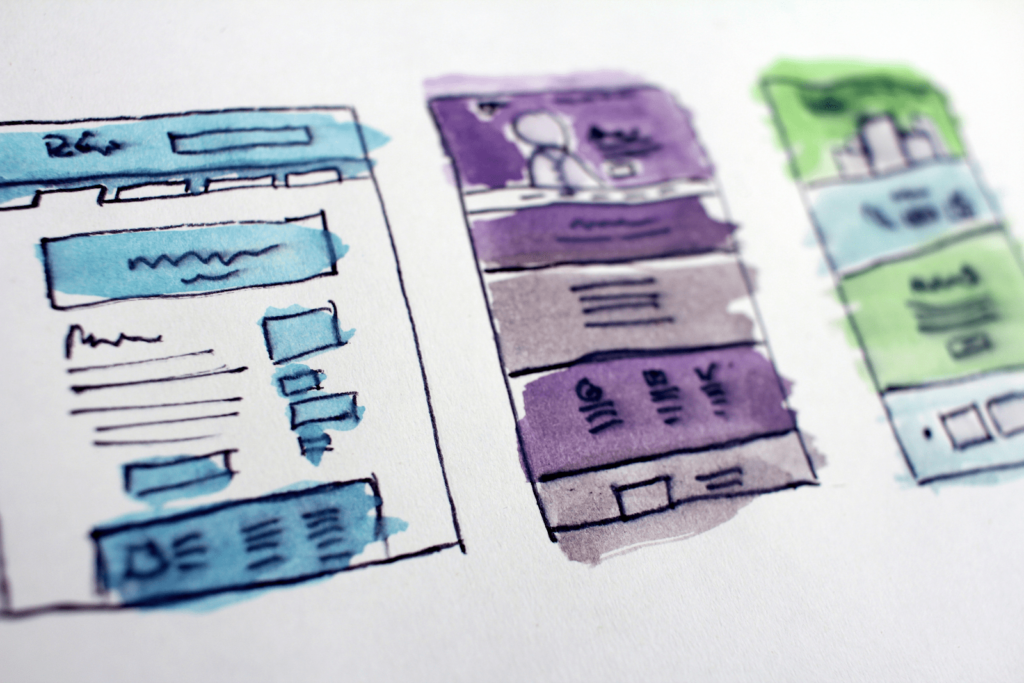Nine B2B and Industrial Marketing Strategies Designed to Get Conversions
Is your website a business card or a salesperson?
In the past, business-to-business, tech, industrial and manufacturing web design and lead generation techniques were very limited. All you could really do was share your information on the web and hope you’d get called. Salespeoples’ outbound efforts did the bulk of the lead generation work. And customers had to talk to them in order to get access to datasheets and technical information. But, that’s changed.
Today a conversion optimized B2B website design can do everything that a salesperson can. And it can be in more places than an individual salesperson and never needs a break. It can attract the right prospects, help them better understand their needs, showcase the value of your solutions, and even nurture a prospect’s interest. All of this can happen before a prospect ever picks up the phone or sends you an email.
So, does your website act like a salesperson or is it falling short? If you feel like your website could do a better job at lead generation and conversions, then read on, for nine B2B marketing strategies that will increase your website’s ROI…
Nine B2B Marketing Strategies That Increase Conversions
1. Look at your site design through your prospect’s eyes

Some marketers think that having a modern, high-end design is a luxury that doesn’t matter in the B2B space. They reason that prospects will care more about the quality of their products and the information on the site than the presentation. But, this isn’t entirely true. Websites for technical buyers need to bypass fluff and provide clear and easy access to information, giving your buyers confidence that picking up the phone to call you will connect them with an expert who can solve their problem. Your website is the first interaction that many prospects have with your brand, and the quality of the presentation content, and overall user experience is how they’ll view the quality of your product, service, and company.
B2B sales generally have a high dollar value, and represent a significant investment by the buyer. Also, if the buyer makes the wrong decision, it could affect their standing with their boss or even jeopardize their job. This means that buyers will take longer to make their decisions and perform more in-depth research. Most of that research will happen directly on your website.
To make sure your website is inspiring confidence instead of confusing, frustrating, or scaring prospects away, try using these best practices:
- If you’re not already, update your site to use a responsive design that adjusts to different screen sizes (phone, tablet, laptop, monitor, and everything in between).
- Add professional photos of your products, office, and team. This custom touch can make your site stand out and make it feel more relatable and personal. Avoid stock images that don’t add any meaningful value.
- Simplify your sitemap. It’s tempting to create hundreds of pages to explain every aspect of your business, but a focused website will usually be more effective.
- Check your buttons, links, and forms regularly to make sure everything is in working order.
- Provide easy access to datasheets, 3d models, or any technical information that a qualified prospect would use in their evaluation of your services and products.
2. Make your message clear
When prospects open your website, do they immediately understand what you do and why it matters? If they don’t, then your site’s messaging might need some improvement. You can create stronger, clearer messaging on your site by:
- Writing clear headlines that include the keywords your prospects are searching for.
- Using the same terms to describe your solutions that your prospects do. You might call it a shovel, but your customers call it a way to dig a hole.
- Focus your message on how you solve the customer’s problems instead of talking about how great you are, or the features that your engineers are the most proud of.
If you market to multiple types of prospects (for example, oil and gas companies and automotive manufacturers), then divide your content up according to the application or industry. You can do this by organizing product listings or case study content by buyer type, in addition to another more product or service-driven categorization. This will help visitors quickly find what they need. - Make it easy for users to ask questions or contact a representative. Contact information should be easy to find on every page of your site.
3. Create a conversion funnel
Think of a conversion funnel like panning for gold. The idea is to weed out prospects that aren’t right for your business until you find those golden prospects that drive your business forward. But, how can you build a conversion funnel on your B2B website? You need to do 4 things:
- Attract: Choose the ways that your site will bring in interested prospects. A basic SEO plan is a great first step for any business that wants to attract customers online. To attract even more people to your business you can utilize tactics such as guest posting on industry sites, creating SEO-optimized helpful content on your own website, social media advertising, or PPC advertising — all of which can attract a high amount of targeted visitors.
- Engage: Once prospects reach your website they need to find information that’s valuable to them and helps them reach their goals. This could be in the form of an FAQ, tutorial, blog post, calculator, or even just a product sheet. You need to offer something of value that will keep them on the page, and equate your brand with expertise.
- Nurture: Offer something of value in exchange for your client’s email address, whether that’s a downloadable worksheet, ebook, consultation, or another business tool. Once you have the prospect’s email address you can send them a series of emails (also known as a drip campaign) to keep helping them solve their challenges.
- Convert: At the end of your campaign, make them an offer. This could be for a consultation with someone from your team, a demo, or something else that might result in a sale.
The idea of a conversion funnel isn’t to get as many leads as possible and pass them all off to your sales team. Instead, your goal is to filter through your prospects and only hand qualified leads over to sales. This will save your sales team time and increase their close rate, reducing your customer acquisition costs.
4. Use SEO and PPC strategically to bring in the right traffic

Don’t just focus on increasing traffic — it’s important to bring in the right traffic. When you know what your best customers are searching for it’s easier to bring more of them in. Start your SEO efforts is by interviewing your best customers to find out what keywords they’re searching for — the actual terms they use for “what they call the solution.” Then optimize your website around what your ideal prospect is looking for. This helps you focus your SEO efforts and is more effective than taking a scattershot approach where you target every possibility.
After you’ve spoken to your customers and chosen some keywords to focus on try using a tool like Moz or SEMrush. These will show you how difficult a keyword is to rank for, how many people search for it per month, and whether it should be a high priority. Once you’ve finalized your selection, try focusing each page of your site on one or two individual keyword phrases by adding them to headings, URLs, image alt text, and metadata. This is a good way to begin boosting your site’s organic traffic.
The next step is using paid advertising to boost your traffic for these keywords. When properly set up, a PPC campaign can bring in highly targeted traffic that’s likely to convert. Your PPC campaign should include:
- Negative keywords: There will always be keywords and brand names that are similar to yours, but unrelated to your services. Adding these to a negative keyword list will ensure you’re not paying for unrelated traffic.
- Geo-targeting: For example, if your company only provides services in the Minneapolis area, then you should only advertise to searchers in the Minneapolis area. Geo-targeting lets you draw this line so that the whole world isn’t seeing your ads.
- Focused ad copy: Creating ad text that’s specific to the keyword the searcher is using can help increase your click-through rate. Grouping keywords that use the same term will make it easier to write unique ads for each group.
By following these best practices, you’ll get higher quality leads from your ads. You’ll also save time by eliminating nuisance leads that aren’t in need of the services that you’re offering.
5. Nurture leads into sales
Nurturing leads becomes a lot easier with the help of marketing automation. Integrating your CRM into your website is a good first step. This will automatically create new CRM entries for any form submissions on your website (of course, you’ll still be notified by email too). This saves you time and makes it more likely that you’ll make use of your CRM’s features.
Once the leads start coming in, you need to have a good process for following up with them. A good first step is to have your CRM generate a confirmation email saying their submission was received. Generally, leads requesting a consultation or service should get a call or email from you within 24 hours (the sooner the better). Leads that sign up to receive a piece of gated content won’t necessarily want or appreciate a call right off the bat. So, it’s best to find other ways to nurture their interest.
One effective option is an email drip campaign. These campaigns send prospects educational information over the course of a few weeks to pique their interest. At the end of the campaign, they’ll receive some type of offer that will move them further down the sales funnel. Once this happens, there’s a good chance it might be time to follow up with them.
6. Leverage lead generation tools like Leadfeeder
Your website will always get traffic that doesn’t convert through a form or chat. These are leads who know about your business and are interested but may need a little coaxing to connect. A tool like Leadfeeder can integrate directly with your website’s analytics, and will show you what companies are viewing your site. From there you can do a little investigation to see who the best person to connect with at that company would be. This is a great method for increasing your total number of leads and keeping your sales team busy.
7. Optimize your site for conversions by using heat mapping
Heat mapping is one of our favorite tools for identifying website optimizations. A tool like Hotjar can show how your site visitors are interacting with your site. Look at what pages they linger on, where they click, and how far they scroll. This will give you a good idea of which elements from your site are contributing to your current conversion rate.
Next, you should see whether you calls-to-action are being viewed or clicked on. For example, you might see that one of your calls-to-action is at the bottom of a page, but only 10% scroll down that far. This is a sign that you should test moving the call-to-action up to a more visible location and see if it has a positive effect on your conversion rates.
You may also find that one of your calls-to-action in a highly visible location isn’t getting as many clicks as it should. In this case, you might try changing the call-to-action, color, or text to see if it affects conversions.
These are just two examples of how very easy design changes can have a impact on your business and website sales.
8. Review your analytics and engagement stats

Knowing how many people are visiting your site is interesting. But, the total number of site visits isn’t necessarily useful for optimizing your B2B conversions. Instead, you need to take a more granular look at your page metrics.
For example, looking at your most viewed pages will show you which pages you need to optimize first. This list will usually include your home page, about page, and a few services pages. These are good places to start optimizing for conversions.
You’ll also probably see a few blog posts or resource pages that get quite a bit of traffic. These can be a good source of optimizations. For example, you could update a blog post from two years ago with new information, restructure it for enhanced readability, or add new keywords to it. You might also realize that your post is missing key components like a call-to-action, content offer, or sign up box.
Engagement stats could also show that your content needs updating. If you see that some of your key pages have a very low time on page metric (for example, less than 25 seconds), then you could update the content to better target your audience. If a page has a high bounce rate, then the links and calls-to-action on that page might not be compelling enough to get visitors to click through. These are just a few ways that analytics and engagement stats can help you choose the right elements to optimize.
9. Segment your offers
People are most drawn to content that speaks to their specific situation. You probably chose to read this post because you’re a marketer. More specifically, you might be a B2B marketer who needs to optimize their company website for conversions. This is why segmented content is so powerful.
Segmenting your offers can have a similar effect. To do this correctly, try splitting your keywords up according to your types of buyers. For example, you might have buyers from the manufacturing vertical and the healthcare verticals. Buyers from each one will have different challenges, needs, and terms they use to describe what you offer. Write down the differences between the two.
Next, take your lists and start thinking about how your content should be segmented. Are there certain products that only a buyer from the healthcare vertical would want? Dividing these from your main product pages under a section called healthcare products might increase the amount of time buyers from that vertical spend on your site.
You can apply this same concept to your blog content, content offers, and forms. This will show buyers your genuine interest in serving them well and give you a headstart on the sales process. The better focus can also increase your conversion rates.
High-converting Industrial B2B Websites Aren’t Built in a Day
Many B2B companies think that once a new website launches, it’s going to stay the same for years. But, as marketers, we know that couldn’t be further from the truth. To create a website that converts well and fits the longer sales cycles of B2B you need to continually optimize your site.
By testing out these nine techniques, you’ll discover what things are helping your conversion rate, as well as the things that are hurting it. From there, you can make logical, incremental adjustments that have a real impact on your bottom line.
If you want to find the best path to higher conversion rates for your business, then contact us. We’d be happy to discuss your goals and work with you to identify potential improvements to your site. This will give you a better sense of ways to optimize your site for conversions and increase your inbound leads.


